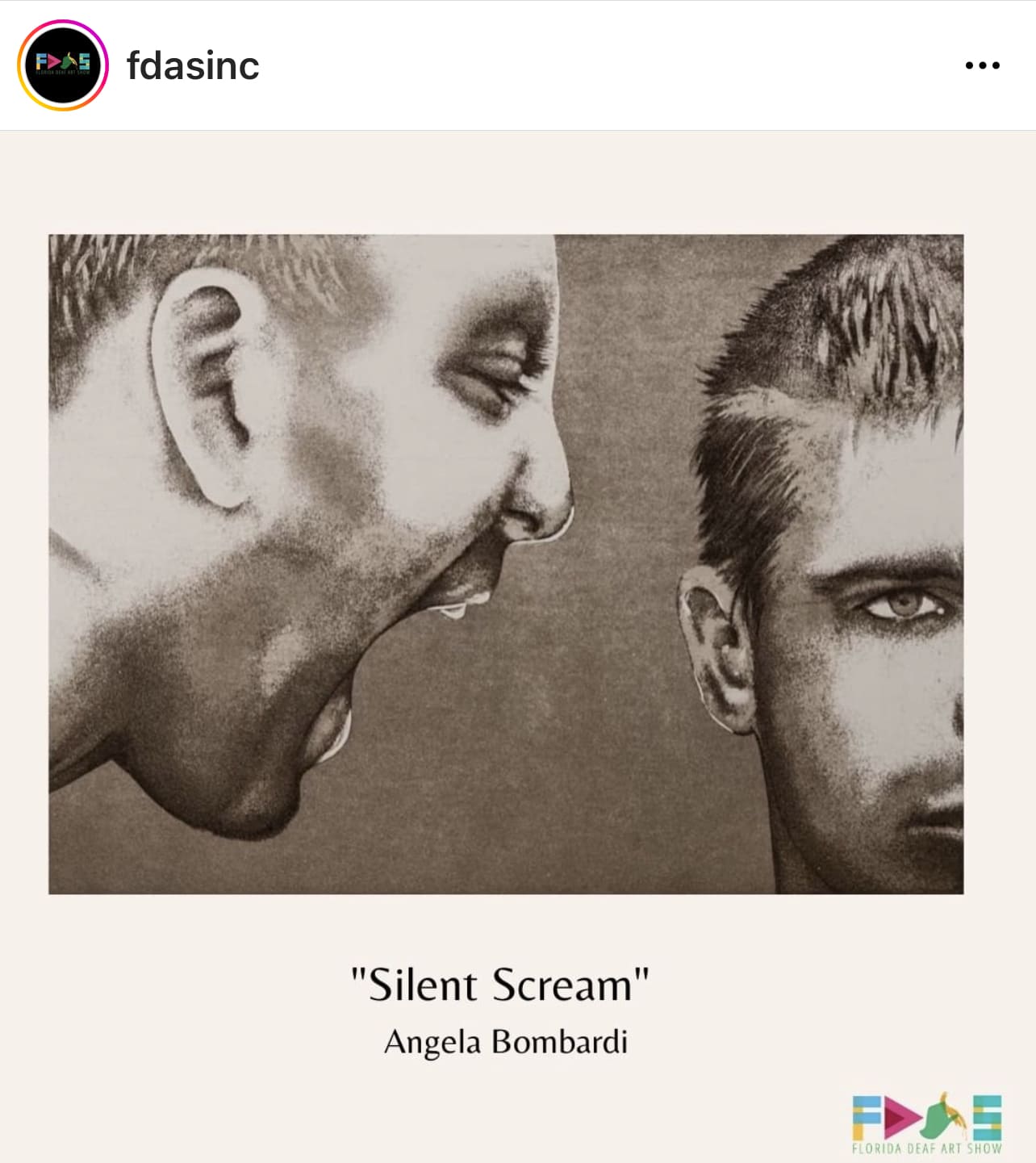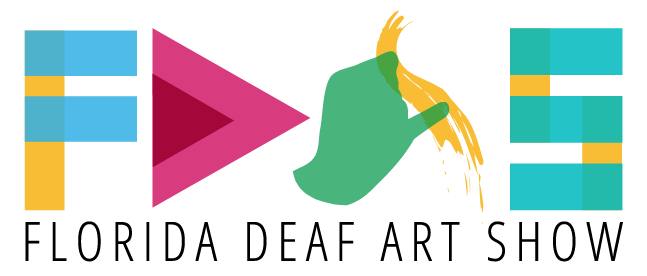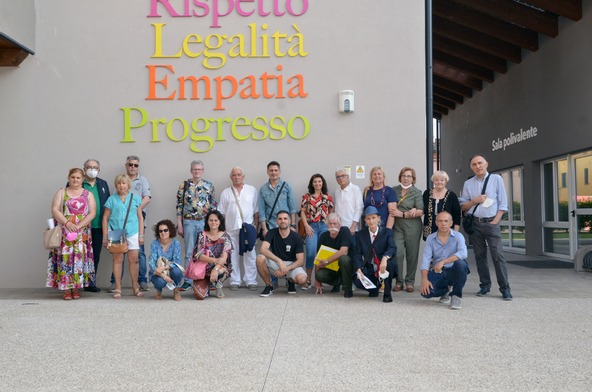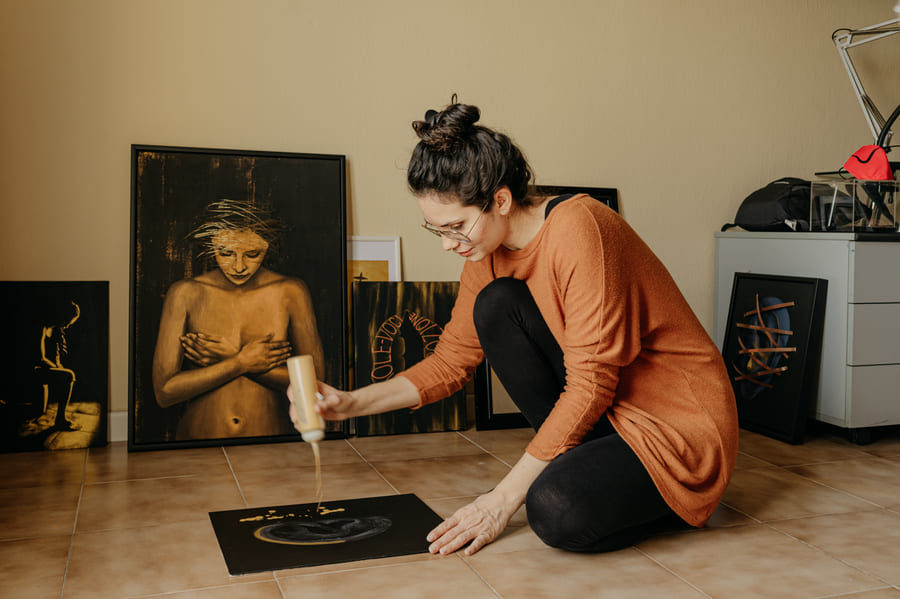Today I’m talking about the Florida Deaf Art Show and how much I liked this project, for which I was selected
In March I made a very pleasant acquaintance: I was selected by a Florida gallery, which published one of my work on its Instagram page, spreading it overseas.
This gallery is called Florida Deaf Art Show and it is an out-of-the-ordinary gallery: it’s a non-profit organization that exhibit art exclusively by deaf artists.
I was blown away by the amount of deaf artists I met through the FDAS shares: all extremely talented. One of the goals of FDAS is to raise funds to help deaf in Florida.
I find their project worthy, so today I would like to talk to you about it, also because this event gave me an opportunity to reflect on how the United States is much more ‘ahead’ on the subject of deafness than Italy.
I recently read an article on Inail’s SuperAbile portal written by a girl named Sheila Zhi Xu, who is a deaf writer who lives between the United States and Italy.
Sheila says that in her country she is able to do many more things than in Italy. For example, US laws provide support for people with disabilities, including deaf ones, regarding to public services (school, medicine, law, workplaces, etc.).
She can take courses at any training institution in the US and receives support for her needs, such as having a live subtitler or sign language interpreter available during classes or events.
In addition, she has free access to the video-telephone retransmission service 24 hours a day, seven days a week, which allows her to call any telephone number, including international ones.
In Italy, Sheila points out that there is no free video-telephone retransmission service 24 hours a day, seven days a week, spread throughout the country.
From the school‘s point of view, each institution decides to what extent it can accommodate deaf students, as Italian law does not necessarily require institutions to provide accessible adjustments or services.
Sometimes the interpreting services are subject to a fee and this has made it difficult for her to find a suitable Italian school.
Here you can read her article Us, deaf people
Florida Deaf Art Show – who are they
Florida Deaf Art Show is a non-profit organization founded in 2013.
It was formerly called Orlando Deaf Art Show and the association was born with the aim of promulgating the inclusive vision of photographer and vice-president Dan Matamoros, creating a place to show the world the work of deaf artists, both emerging as well as established, to expose their talents to the international community.
Over time and thanks to a lot of passion and innovation, the organization has grown in popularity and, although it suffered a halt in 2015, shortly after the project resumed and evolved into the Florida Deaf Art Show.
Florida Deaf Art Show – what they do
The association organizes exhibition festivals in several major Florida cities, with the aim of turning the spotlight on deaf artists and supporting their talents.
At the same time, the association is committed to raising funds and raising awareness to the programs dedicated about deaf, especially in the cities that host annual exhibitions.
The idea is to improve the quality of life of deaf and hearing-impaired people, and create opportunities for artistic and social growth for them.
To achieve this goal, the Florida Deaf Art Show creates at least two fund-raising events and one art exhibition a year, involving about 400 people.
The association’s motto is “Deaf Can!” and the support it offers is based on building an inclusive environment step by step, where art is seen as a bridge capable of uniting deaf and hearing people.
Not only that, because FDAS also provides an online platform for deaf artists, so that they can show their works worldwide.
Thanks to the portal and social networks, FDAS is therefore empowering the entire community of people suffering from deafness, with the intent of building a future without fear, in an increasingly accessible world.
Florida Deaf Art Show – the artists
Thanks to FDAS I was able to learn about the work of many deaf artists around the world. It’s amazing to see the variety of expressive forms and techniques that characterize each of them!
I liked the works of Maryam Hafizirad, a deaf Canadian Persian painter and sculptor.
According to her biography, Maryam has exhibited in many countries around the world including Iran, China, Germany, Malaysia, India and Canada.
Her art is inspired by Persian culture and for painting she uses acrylic, shattered stained glass and watercolor – she uses primarily symbols of her Persian and deaf identity – such as pomegranates, which are icons of liberated hidden love, fish, beings living in a silent world of pure beauty and birds, who embody freedom.
Another artist that struck me a lot is the newyorker Nicole Wheat, who in her biography tells of being born with severe hearing loss and spending her youth struggling with communication, often feeling disconnected with her peers.
At the age of 28, she began to lose her sight and was diagnosed with Usher syndrome, a rare and incurable genetic disorder, which includes hearing loss, balance problems and the onset of retinitis pigmentosa, a degenerative eye disease.
Nicole found her sense of life in art and today she creates works with a nocturnal and visionary atmosphere, where the eyes are almost always present.
To conclude, I am honored to have been selected by the Florida Deaf Art Show, which shared my artwork “Silent Scream“ on its platform.

Like many artists, I also dream of exhibiting in the United States!
I hope that in the future there will be an opportunity to exhibit at the FDAS exhibition to get to know other deaf artists like me, to contribute my art to this beautiful and valiant project.




